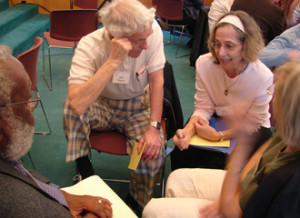 In my last post I promised a full script for debriefing an activity. Truth be told, I promised it for the next day but it’s been over a week! So for those of you who have been waiting patiently, here is the script. This is the most important key to leading a successful interactive presentation. What is written below assumes you have completed the Three Wise Monkeys game (the Do part of D.R.A.G.) and that you started it without any fanfare or introduction. You just jumped into it.
In my last post I promised a full script for debriefing an activity. Truth be told, I promised it for the next day but it’s been over a week! So for those of you who have been waiting patiently, here is the script. This is the most important key to leading a successful interactive presentation. What is written below assumes you have completed the Three Wise Monkeys game (the Do part of D.R.A.G.) and that you started it without any fanfare or introduction. You just jumped into it.
Say: Take a minute and introduce yourself to your two partners in the game. Say a little bit about where you’re from and what you do. (allow one minute for this and warn them at 15 seconds before calling them back to attention.) Now meet another group of three and form a group of six. Once you’ve found the other group introduce yourselves to each other and take a seat (if there are tables they can sit around a table or just circle up chairs. Allow one and a half minutes for introductions and warn with 30 seconds left).
Say: In your groups I’d like to talk about the game we just played. Starting with the person whose birthday is closest to today and then going around to their right have each person share your experience of the game. What did you think about the game? How did you try to figure out what the others might do? What, if any, strategy did you consider? I’ll give you about three minutes to talk about this…go! (Allow the three minutes. If it seems groups have not finished discussing give an extra 30 seconds but not more than that.)
Say: Now in your groups, starting with the person who spoke last, take a few minutes and talk about what you could’ve done differently in this game. For example, if you were to play this again how might you adjust your strategy? How would you change the game, if you could, and why would you make those changes? I’ll give you another three minutes…go!
This next section is crucial to success. It’s the part where you gather information from the small groups. I suggest you have a flip chart or white board where you can record the responses. These responses will form the basis for some of your presentation. This is where you draw out learnings from the game that play into the next step in D.R.A.G. The generalize portion.
Say: I’d like to hear some of what you’ve been talking about and record it up here. Please share some of your strategies and what you thought about this game. (Accept all answers and write them on the board being careful to capture exactly what is said by each participant who shares. You want to be able to use their words to make your point. This is important.)
Say: Okay, there are a couple of questions I’d like you to discuss now in your groups as we wrap this up. How is this game like working with a team at your office? The other question I’d like you to talk about is, how are the strategies you came up with like or unlike your team strategy? You’ll have five minutes to talk about this…go!
After the five minutes is up…and you can stretch it if you think the conversation is productive…ask each small group to share their answers and, again, record them on a flip chart or white board. If at all possible keep the earlier answers visible, as well (in other words don’t erase anything if you can help it). Some, if not many, of the answers will be similar. The information and insights you’ve gathered from the participants can now be used to support the rest of your presentation. Thank everyone and dismiss them to return to their original seats.
In my next post I’ll dig into this script and explain why each piece is necessary and how to make the most out of the process. I can’t say it often enough, the success of interactive presentations hinges on this debriefing piece. Do it well and your presentation will be awesome. Do it poorly and your presentation will be average…at best.
Leave a Reply